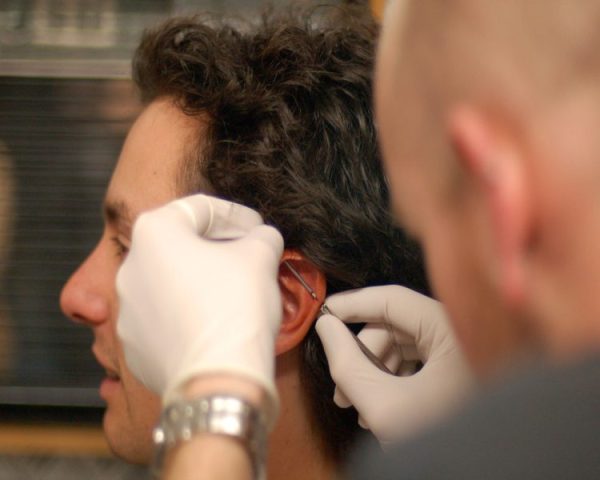From being a status symbol to a style statement, the history of body piercing has seen it all. With this article, explore interesting information on the origin & background of body piercing.
History Of Body Piercing
Did you know that the art of body piercing goes back to the prehistoric age? If no, then this article would surely be a revelation of sorts. Once started in the European era, the art is a rage in the present times, thanks to the superstars and fashions aficionados. Did you know that body piercing has also been mentioned in the Bible, in Old Testament? As per it, body jewelry was considered a mark of beauty and wealth, especially for Bedouin and nomadic tribes during that time and was given as a bridal gift or as part of a dowry. Let us explore the history of body piercing in detail. 

Image: arriba@flickr
Interesting Information On Origin & Background Of Body Piercing
Prehistoric Age
The beginning of body piercing can be traced back to the prehistoric times. The Egyptian mummies dating 5000 years back can be seen having pierced ears, with larger-gauge plugs in the ears. It is a well known fact that Egyptians loved to beautify themselves and piercing was one such way for the same. For them, piercing was a status symbol and reflected a person’s love for beauty. While the mass was allowed to pierce their ears and flaunt elaborate enameled and gold earrings, only the Pharaoh was allowed to pierce his navel. Anyone other than the Pharaoh seen with a navel piercing was executed to death.
Early Age
In the early age, piercing emerged as a badge of honor, rather than just being a status symbol or an object of beauty. Roman centurions pierced their nipples to mark their strength and virility. Piercing showcased their dedication for the Roman Empire and served as a symbol for unifying and bonding the army. Genital piercing was also practiced during this time, but it was mainly for the slaves, in order to prevent serious injury and sex. Around this time, the Aztecs, Maya and some American Indians started the art of tongue piercing as a part of their religious rituals. It was believed that tongue piercing would bring them closer to God. Nose piercing also emerged during this time and basically stood as a sign of appearing vicious than the enemies.
The practice of body piercing also started in New Guinea and Solomon Islands. The tribes used bone, tusks and feathers to smarten their body part. A century later, French discovered American Indians with this body art. Known as Nez Perce, or Pierced Noses, it was mainly used to enhance certain features. Around this time, women in Central and South America flaunted lip labrets. These were fashion statements, as women with lip labrets were considered attractive and appealing than their counterparts. The Aztecs and Mayans also sported lip labret to enhance their sexuality. The labrets were generally made of gold and jade and had mythical or religious figures carved into them. However, the progress of this art came to a halt when medieval church condemned it as sinful. For a century or so, the art slowly faded away.
Medieval Age
Just when Renaissance went into full swing, interest in piercing also began to flourish. At that time, sailors were both religious and superstitious. They believed that piercing one ear would improve their long-distance sails. Also, it was said that whoever found a sailor washed ashore after a shipwreck can keep the gold ring in his ear, in return for providing a proper Christian burial. Fashion began to pick up for both men and women during the Elizabethan age. Men from the royal background were supposed to flaunt at least one earring. Pearls and diamonds replaced tusks and bones and were considered as a status symbol. While men showcased their status, women were not too far behind. They, along with men, started piercing their nipples not just to show off their jewelry, but to add sensual pleasure and sensitivity on bed. Victorian age further heightened genital piercing.
Modern Era
In the beginning of the modern era, body piercing was limited to ears only. The Puritan movement did away with men wearing earrings, but just as they say, you just cannot get rid of art, body piercing soon bounced back. Nose piercing started gaining popularity, thanks to Indian women adoring this art from the sixteenth century. While it was a part of a traditional ritual for Indian women, for teens in US, it was mainly a way to display their rebellion. With this, began the resurrection of body piercing. The fever soon caught up among men, women and kids alike, as more and more people started flashing new body piercing. Today, body piercing has become a part of the style statement and a way to grab the attention and be an eye-catcher!!
See also
More from iloveindia.com
- Home Remedies | Ayurveda | Vastu | Yoga | Feng Shui | Tattoos | Fitness | Garden | Nutrition | Parenting | Bikes | Cars | Baby Care | Indian Weddings | Festivals | Party ideas | Horoscope 2015 | Pets | Finance | Figures of Speech | Hotels in India : Delhi | Hyderabad | Chennai | Mumbai | Kolkata | Bangalore | Ahmedabad | Jaipur
- Contact Us Careers Disclaimer Privacy Policy Advertise With Us Lifestyle Sitemap Copyright iloveindia.com. All Rights Reserved.







